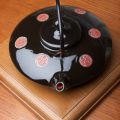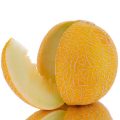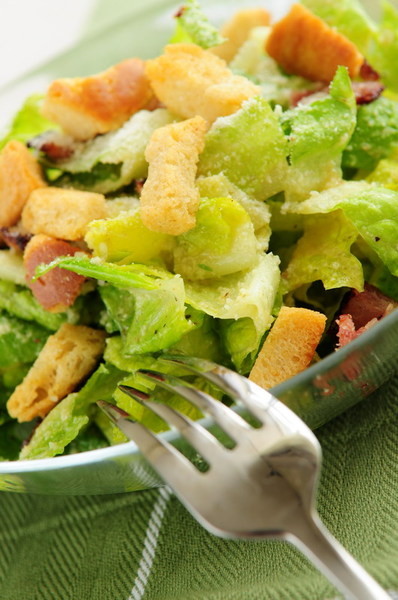 Caesar salad classic recipe Back in 1896In the year, not far from the town of Lago Maggiore, in Italy, a boy was born who was named Caesar. Not Gaius Julius, of course, but simply Caesar, with a simple Italian surname Cardini. After the First World War, he and his brother Alex emigrated to the United States, where he opened a small establishment combining a hotel and a restaurant called "Caesar's Place", which can be translated as "At Caesar's". More precisely, Cardini opened this establishment not in the United States itself, but in Mexico, in the town of Tijuana, 20 miles from the city of San Diego, where he himself lived. This geographical state of affairs made it possible to have a profitable business bypassing the prohibition that was raging in the United States at that time. One Independence Day, July 4, 1924, Cardini's was occupied by Hollywood stars who had crossed the border with the sole purpose of having a good drink. Caesar's had no problems with drinks, but snacks were a problem: all decent supplies had run out, and the nearest stores were closed. All that Caesar's had left were eggs, olive oil, lettuce, bread, Worcestershire sauce, Parmesan cheese, and garlic. To somehow correct his imprudence, Cardini mixed what he had and offered THIS to his guests. This is how the world saw the first salad, which was later named after its inventor, and was completely delighted. This is the canonical version of the appearance of the Caesar salad. came to light, first told by Cardini's daughter, Rosa. The story later appeared in such respected sources as the Chicago Tribune (July 23, 1987), The Santa Fe New Mexican (May 28, 1997), Tulsa World (July 9, 1997) and many others, by which time it had become surrounded by rumors and speculation. It was rumored, for example, that Clark Gable and Jean Harlow were among the first lucky ones to try the great restaurateur's creation. Although in fact this did not happen, because it could not have happened: in 1924, Gable was still young and unknown to anyone, and Jean Harlow was only 13 years old. The only person who claims to have been at Caesar's on that historic day and tasted the new dish was Julia Child, who was brought along by her parents. Julia Child later became a famous cookbook author.
Caesar salad classic recipe Back in 1896In the year, not far from the town of Lago Maggiore, in Italy, a boy was born who was named Caesar. Not Gaius Julius, of course, but simply Caesar, with a simple Italian surname Cardini. After the First World War, he and his brother Alex emigrated to the United States, where he opened a small establishment combining a hotel and a restaurant called "Caesar's Place", which can be translated as "At Caesar's". More precisely, Cardini opened this establishment not in the United States itself, but in Mexico, in the town of Tijuana, 20 miles from the city of San Diego, where he himself lived. This geographical state of affairs made it possible to have a profitable business bypassing the prohibition that was raging in the United States at that time. One Independence Day, July 4, 1924, Cardini's was occupied by Hollywood stars who had crossed the border with the sole purpose of having a good drink. Caesar's had no problems with drinks, but snacks were a problem: all decent supplies had run out, and the nearest stores were closed. All that Caesar's had left were eggs, olive oil, lettuce, bread, Worcestershire sauce, Parmesan cheese, and garlic. To somehow correct his imprudence, Cardini mixed what he had and offered THIS to his guests. This is how the world saw the first salad, which was later named after its inventor, and was completely delighted. This is the canonical version of the appearance of the Caesar salad. came to light, first told by Cardini's daughter, Rosa. The story later appeared in such respected sources as the Chicago Tribune (July 23, 1987), The Santa Fe New Mexican (May 28, 1997), Tulsa World (July 9, 1997) and many others, by which time it had become surrounded by rumors and speculation. It was rumored, for example, that Clark Gable and Jean Harlow were among the first lucky ones to try the great restaurateur's creation. Although in fact this did not happen, because it could not have happened: in 1924, Gable was still young and unknown to anyone, and Jean Harlow was only 13 years old. The only person who claims to have been at Caesar's on that historic day and tasted the new dish was Julia Child, who was brought along by her parents. Julia Child later became a famous cookbook author.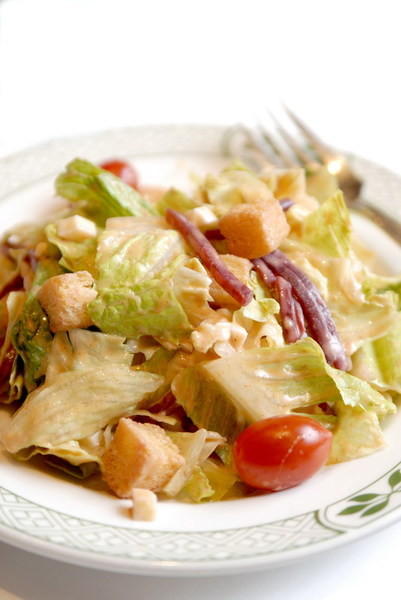 So what exactly did Caesar feed the hot one?a crowd of movie people? After going over several options in his mind, Cardini chose, as it is now clear, the only correct one. He rubbed a plate with garlic, laid out lettuce leaves on it, poured oil over it, broke eggs into it, prepared in a special way (namely, the eggs were lowered into boiling water for exactly 60 seconds, while the water itself did not boil, as a result, the egg consistency turned out to be like a good dressing), added grated cheese, lemon juice, seasonings and croutons made with olive oil and garlic. That's it! There were no anchovies, no other ingredients whatsoever in the classic salad. As for the anchovies, Caesar's brother Alex Cardini, who, having left the service of a military pilot, joined his brother's restaurant business in 1926-27, tried hard. He added anchovies to the salad when he treated American pilots from San Diego to it, and called this variation the "Aviator's Salad". Caesar himself was very negative about the anchovy innovation, saying that Worcestershire sauce was enough to give the salad a piquant taste. Caesar also claimed that a real salad should only be prepared with Italian olive oil and Italian Parmesan. There is a version that Alex Cardini, shortly before his death in 1975, met Diana Kennedy in Mexico City, to whom he told about "his" salad. Diana became interested in the culinary details of this dish, and thanks to her, the misconception spread that the classic "Caesar" salad should include anchovies. One of the "scandalous" The journalist Neil Matthews told the versions of the birth of the famous salad on the pages of his newspaper "San Diego Union-Tribune" (from March 2, 1995). He told about a certain Livio Santini, an old-timer of Tijuana, who claims that it was he, Livio, who created this salad based on his mother's recipe when he worked in the kitchen of Caesar's restaurant at the age of 18. And then, allegedly, Cardini took the recipe directly from him and "appropriated" the invention for himself. There are as many reasons to believe this story as there are not, especially considering the popularity that the salad had by 1995. The author of another, highly controversial, version is George Leonard Herter, who wrote in his book "Bull Cook and Authenti Historical Recipes and Practices" that the "Caesar" salad was first prepared in 2026; In 1903, Giacomo Giugnia, an Italian chef in Chicago, was the chef at a small restaurant called The New York Cafe, and he was trying to please American tastes, since the popular Italian foods of spaghetti and pizza were of little demand outside the Italians themselves. It was then that a salad was invented, which Giacomo called Caesar, in honor of the greatest Italian Caesar, Gaius Julius. The salad itself was made from romaine lettuce. Giugnia did not expect that his salad would become incredibly popular. Many traveling chefs asked him for the recipe, and soon Caesar was a popular salad. spread not only throughout North America, but even in Europe.
So what exactly did Caesar feed the hot one?a crowd of movie people? After going over several options in his mind, Cardini chose, as it is now clear, the only correct one. He rubbed a plate with garlic, laid out lettuce leaves on it, poured oil over it, broke eggs into it, prepared in a special way (namely, the eggs were lowered into boiling water for exactly 60 seconds, while the water itself did not boil, as a result, the egg consistency turned out to be like a good dressing), added grated cheese, lemon juice, seasonings and croutons made with olive oil and garlic. That's it! There were no anchovies, no other ingredients whatsoever in the classic salad. As for the anchovies, Caesar's brother Alex Cardini, who, having left the service of a military pilot, joined his brother's restaurant business in 1926-27, tried hard. He added anchovies to the salad when he treated American pilots from San Diego to it, and called this variation the "Aviator's Salad". Caesar himself was very negative about the anchovy innovation, saying that Worcestershire sauce was enough to give the salad a piquant taste. Caesar also claimed that a real salad should only be prepared with Italian olive oil and Italian Parmesan. There is a version that Alex Cardini, shortly before his death in 1975, met Diana Kennedy in Mexico City, to whom he told about "his" salad. Diana became interested in the culinary details of this dish, and thanks to her, the misconception spread that the classic "Caesar" salad should include anchovies. One of the "scandalous" The journalist Neil Matthews told the versions of the birth of the famous salad on the pages of his newspaper "San Diego Union-Tribune" (from March 2, 1995). He told about a certain Livio Santini, an old-timer of Tijuana, who claims that it was he, Livio, who created this salad based on his mother's recipe when he worked in the kitchen of Caesar's restaurant at the age of 18. And then, allegedly, Cardini took the recipe directly from him and "appropriated" the invention for himself. There are as many reasons to believe this story as there are not, especially considering the popularity that the salad had by 1995. The author of another, highly controversial, version is George Leonard Herter, who wrote in his book "Bull Cook and Authenti Historical Recipes and Practices" that the "Caesar" salad was first prepared in 2026; In 1903, Giacomo Giugnia, an Italian chef in Chicago, was the chef at a small restaurant called The New York Cafe, and he was trying to please American tastes, since the popular Italian foods of spaghetti and pizza were of little demand outside the Italians themselves. It was then that a salad was invented, which Giacomo called Caesar, in honor of the greatest Italian Caesar, Gaius Julius. The salad itself was made from romaine lettuce. Giugnia did not expect that his salad would become incredibly popular. Many traveling chefs asked him for the recipe, and soon Caesar was a popular salad. spread not only throughout North America, but even in Europe.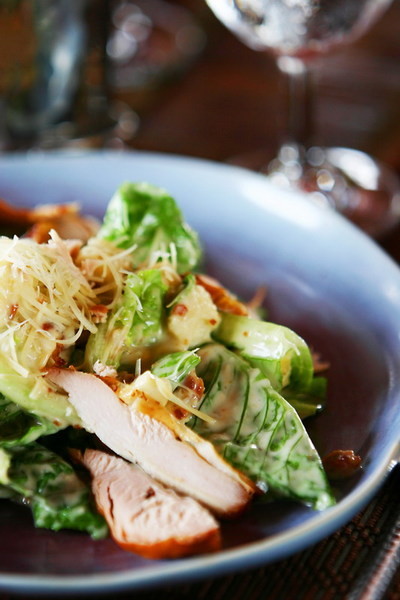 However, whatever may be said about the realroots of the Caesar salad, but it was Cardini's Caesar salad that gained the greatest fame. His salad became a dish that people came to Tijuana for. The European debut of the Caesar salad took place thanks to the wife of Prince Edward VIII of Wales. The princess traveled a lot, including to San Diego and Tijuana in the 1920s, and was an avid fan of Cardini's salad. It is said that it was in this area that she met her future husband. There is another legend (or maybe not a legend) associated with the princess and the salad. Initially, Cardini served the lettuce leaves whole, taken from the plate directly with the fingers, but the princess was the first to ask for the lettuce leaves to be torn into pieces so that it could be eaten with a knife and fork. This is described in the book by Terry D. Greenfield, "In Search of Caesar". After the repeal of Prohibition in 1934 and a new law banning casinos in Mexico (1935), Cardini sold his establishment in Tijuana and moved to Los Angeles. By the way, the restaurant in Tijuana still exists. There is such a funny fact in the history of the salad: when in 1948 Caesar and Rosa Cardini decided to engage in the wide sale of their signature dressing, it turned out that Cardini could not register the name "Caesar salad" itself - by that time it had already become public domain and he had to limit himself to the brands "Original Caesar" and "Cardini". In 1953, 3 years before Caesar Cardini's death, the salad was awarded the Epicurean Society in Paris as the "best recipe to appear in America in the last 50 years". Cardini died in 1956, leaving his descendants one of the best recipes that the golden fund of world cuisine is rich with. Today, the name "Caesar Salad" does not necessarily hide the same "Caesar" that was created in Tijuana in 1924. There are as many variations of its preparation as there are chefs, and they all have the right to be called by this proud name. Although the classic will always remain a classic. Unsurpassed Caesar Salad Light Ingredients:
However, whatever may be said about the realroots of the Caesar salad, but it was Cardini's Caesar salad that gained the greatest fame. His salad became a dish that people came to Tijuana for. The European debut of the Caesar salad took place thanks to the wife of Prince Edward VIII of Wales. The princess traveled a lot, including to San Diego and Tijuana in the 1920s, and was an avid fan of Cardini's salad. It is said that it was in this area that she met her future husband. There is another legend (or maybe not a legend) associated with the princess and the salad. Initially, Cardini served the lettuce leaves whole, taken from the plate directly with the fingers, but the princess was the first to ask for the lettuce leaves to be torn into pieces so that it could be eaten with a knife and fork. This is described in the book by Terry D. Greenfield, "In Search of Caesar". After the repeal of Prohibition in 1934 and a new law banning casinos in Mexico (1935), Cardini sold his establishment in Tijuana and moved to Los Angeles. By the way, the restaurant in Tijuana still exists. There is such a funny fact in the history of the salad: when in 1948 Caesar and Rosa Cardini decided to engage in the wide sale of their signature dressing, it turned out that Cardini could not register the name "Caesar salad" itself - by that time it had already become public domain and he had to limit himself to the brands "Original Caesar" and "Cardini". In 1953, 3 years before Caesar Cardini's death, the salad was awarded the Epicurean Society in Paris as the "best recipe to appear in America in the last 50 years". Cardini died in 1956, leaving his descendants one of the best recipes that the golden fund of world cuisine is rich with. Today, the name "Caesar Salad" does not necessarily hide the same "Caesar" that was created in Tijuana in 1924. There are as many variations of its preparation as there are chefs, and they all have the right to be called by this proud name. Although the classic will always remain a classic. Unsurpassed Caesar Salad Light Ingredients:
- 2 slices of sweet bread, cut into small cubes
- 2 tablespoons grated parmesan cheese
- salt, black pepper to taste
- 1 clove garlic, passed through the press
- 1 garlic clove, cut into thin strips
- 1 head of romaine lettuce
- 1 tablespoon of anchovy paste
- 2 tablespoons of olive oil
- 3 tablespoons fresh lemon juice
- 1 teaspoon Dijon mustard
Preparation: Preheat oven to 180C. Sprinkle a small baking sheet with a small amount of olive oil. In a large closing plastic bag, combine the bread cubes with garlic, salt and pepper. Seal the bag, shake it a few times, so that the garlic, salt and pepper are evenly distributed throughout the bread. Place the bread cubes on a baking sheet in one layer and put in the oven for about 12 minutes, periodically turning the cubes so that they are baked on all sides until golden. Remove the crackers and let cool. At this time, wash and dry romaine lettuce, tear it into pieces and leave in a paper towel in the refrigerator until use. Now in a wooden bowl, mash the anchovy pasta and garlic, add salt, pepper, beat the mixture well with a fork. Continue to beat, add olive oil, lemon juice and mustard. When all the ingredients are mixed into a homogeneous mass, put a fresh salad, parmesan and croutons into it. Gently mix and decorate the salad with a few crackers. Serve immediately.





